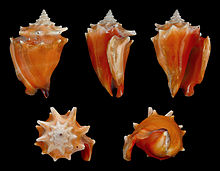Strombus pugilis
| Fighting conch | |
|---|---|
 |
|
| Five views of a shell of Strombus pugilis | |
| Scientific classification | |
| Kingdom: | Animalia |
| Phylum: | Mollusca |
| Class: | Gastropoda |
| (unranked): | clade Caenogastropoda clade Hypsogastropoda clade Littorinimorpha |
| Superfamily: | Stromboidea |
| Family: | Strombidae |
| Genus: | Strombus |
| Species: | S. pugilis |
| Binomial name | |
|
Strombus pugilis Linnaeus, 1758 |
|
| Synonyms | |
|
|
Strombus pugilis, common names the fighting conch and the West Indian fighting conch, is a species of medium to large sea snail, a marine gastropod mollusk in the family Strombidae, the true conchs.
S. pugilis is closely similar to Strombus alatus, the Florida fighting conch. It is unsettled whether they are distinct species or merely subspecies.
The maximum recorded shell length is 110 mm or up to 130 mm, commonly to 90 mm.
Like other species in the same genus, Strombus pugilis has a robust, somewhat heavy and solid shell, with a characteristic stromboid notch. It has a well-developed body whorl and a short and pointed spire. It presents 8 to 9 whorls, each of them having a single row of subsutural spines, becoming larger towards the last whorl. These spines, however, may be less conspicuous or even absent in some populations. Its aperture is relatively long and slightly oblique. The posterior angle of the outer lip is distinct, projecting in the posterior direction in an erect fashion. The operculum is sickle-shaped, similar to several other Strombus snails.
The shell color varies from salmon-pink, cream or yellow to light or strong orange, and the interior of the aperture is usually white. The anterior end presents a dark purple stain, which is one of the diagnostic characters of this species, and is absent in Strombus alatus.
This species is closely similar to Strombus alatus, which has a more northerly range. Strombus alatus shells have less prominent subsutural spines and a slightly more projected outer lip. Some scientists have treated the two as distinct species; others as subspecies. In an extensive study of the Stromboidea in 2005, Simone provisionally treated these as distinct species, but observed that "no spectacular morphological difference was found [and] all related differences, even those of the genital system, can be regarded as extreme of variation of a single, wide distributed, variable species."
...
Wikipedia
